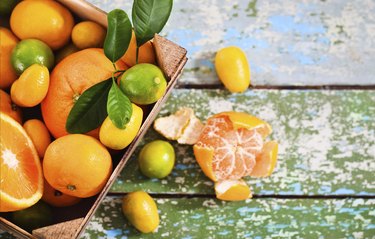
Citric acid occurs naturally in fruits and vegetables, and serves as a natural preservative and flavoring in foods and drinks. Citric acid in food is also crucial in the Krebs cycle of human metabolism, involving the oxidation of fats, proteins and carbohydrates.
Foods with citric acid can be found in the orchard, garden and your local grocery store. Citric acid benefits aren't limited just to food. It is also widely used in cleaning products, air fresheners, candles, hand sanitizers and personal care products.
Video of the Day
Video of the Day
Read more: What Are the Side Effects of Too Much Citric Acid?
Citric Acid in Food
Foods naturally containing citric acid include citrus fruits such as lemons, oranges and limes, according to a February 2015 study published by International Journal of Basic & Applied Sciences. Berries, except for blueberries, also contain citric acid, particularly strawberries, raspberries, gooseberries and cranberries. Pineapples, cherries, tomatoes, some varieties of peppers, artichokes and certain varieties of lettuce also contain citric acid.
As an additive, citric acid preserves processed foods, giving them a longer shelf life, according to a 2015 article published by the European Food Safety Authority. In the making of cheese, citric acid helps to ferment milk faster, making it an essential part of large-scale cheese production. Traditionally, cheese is made by adding a bacterial culture to milk, allowing it to ferment slowly. Commercially produced cheese uses citric acid to speed up this process. Soft drinks, particularly fruit-flavored varieties, contain citric acid added as a preservative and as a flavoring.
Less-expensive frozen treats use citric acid as a fat emulsifier to keep the added vegetable fats from separating in ice cream, sherbet, and sorbet. When added to sodium bicarbonate, it prompts an effervescent action in candy and powdered drinks, as well as powders and tablets for indigestion.
Beverages and Citric Acid
Citric acid in fruits — such as grapes used for wine — include tartaric, malic and citric acid. These add to a vintage's total acidity and influence the color, balance and taste of the wine. These acids also influence the growth of yeasts during the fermentation process, limiting bacterial growth.
Most of the citric acid found in inexpensive, commercially distributed wine is the result of fermenting sucrose solutions added after the fermentation process.
Citric acid is also found in fruit and vegetable juices, soft drinks, beverage syrups and ciders, according to a 2015 article published by Frontiers in Life Science.
Read more: Is Citric Acid Bad for You?
Restaurant Food and Citric Acid
Asian foods often contain lemon and lime juice, which contains citric acid. Indian foods often have tamarind, a fruit that contains citric acid. Chinese recipes usually do not use citrus fruits and citric acid additives, except for lemon chicken and various sweet-and-sour recipes containing pineapple, orange and lemon.
Mediterranean food may include tomatoes, lemon juice, lime juice, pineapple and other fruits. Middle Eastern food usually does not contain citrus fruits; however, hummus can be made with or without lemon juice. American food abounds with naturally occurring citric acid, and citric acid as an additive features in relishes, ketchup, mayonnaise, desserts and main courses.
- Frontiers in Life Science: "Overview of Citric Acid Production from Aspergillus niger"
- European Food Safety Administration: "Scientific Opinion on the Safety and Efficacy of Citric Acid When Used as a Technological Additive (Preservative) for All Animal Species"
- International Journal of Basic & Applied Sciences: "Quantitative Assessment of Juice Content, Citric Acid and Sugar Content in Oranges, Sweet Lime, Lemon and Grapes Available in Fresh Fruit Market of Quetta City""
- Encyclopedia Britannica: Citric Acid